Baby Sun Rose (Aptenia Cordifolia) Profile: Plant Complete Info & Care Guide
Written by Maggie
Dec 23 2021
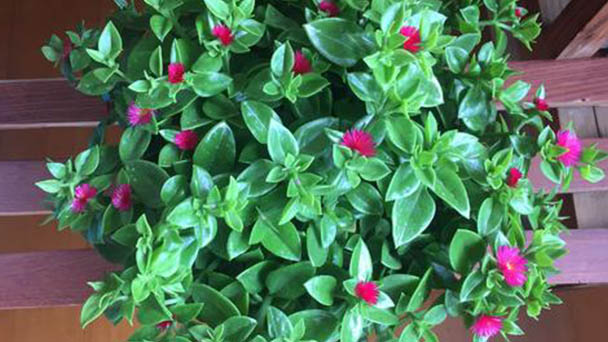
Baby Sun Rose, scientific name Mesembryanthemum cordifolium, formerly known as Aptenia cordifolia, its leaves are thick and green. Baby Sun Rose is an evergreen and rapidly growing succulent, usually short-lived perennial, 250 mm tall. The fleshy stems of Baby Sun Rose are quadrate or rounded, 600 mm long and grow flat.
Baby Sun Rose blooms on the top of the branches, the color is rose-red; Flowery period continues from spring to autumn, can appreciate flowers and can view leaves already. It is one of the excellent potted flowers that decorates the sitting room, window sill.
Baby Sun Rose Picture
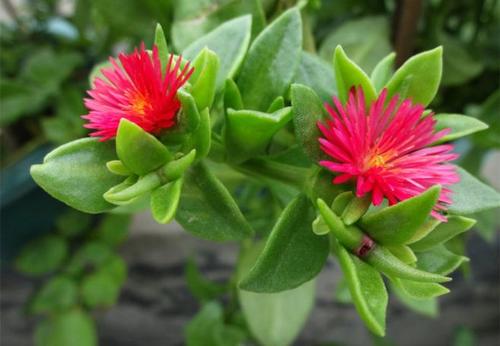
Baby Sun Rose Features
Baby Sun Rose is a perennial evergreen vine fleshy herb. Branches are about 20 cm long, (there are longer leaves opposite), fleshy, bright green. Branches have edges and corners, elongate after a semi-porcine shape. The branches of baby sun rose blossom at the top and branch out after the flowers. The flower is deep rose red, the center is light yellow, the shape is like chrysanthemum, the petal is narrow, has a luster, and from spring to autumn it opens successively.
Baby Sun Rose is an evergreen perennial herb. Stems are decumbent, diffuse, 30-60 cm long, branched, slightly fleshy, glabrous, with small granular protuberances. Leaves are opposite, leaves cord-ovate, flattened, 1 -- 2 cm long, ca. 1 cm wide, apically acute or obtuse with a convex tip, base rounded, entire; Petiole of Baby Sun Rose is 3-6 mm long. Flowers are singly terminal or axillary, ca. 1 cm in diam. Pedicels 1.2 cm long; Calyx is 8 mm long, lobes 4,2 large, obconic, 2 small, linear, persistent; Petals of Baby Sun Rose are numerous, reddish-purple, spatulate, ca. 1 cm long; Stamens numerous; Ovary is inferior, 4-loculed, style absent, stigma 4-lobed. The capsule is fleshy, stellate 4-valved;
| Botanical/Scientific Names | Mesembryanthemum cordifolium, aptenia cordifolia |
| Common Names | Baby Sun Rose |
| Native Area | South Africa |
| Plant Type | Succulent, ampel, perennial evergreen vine |
| Bloom Time | Spring to autumn |
| Flower Color | Rose red |
| Lighting Requirements | Bright but indirect light |
| Soil Care | Soil with good air permeability and drainage |
| Propagation | Usually cutting propagation |
| Poisonous | Heartleaf Ice plant is not toxic, but the sap is mildly irritating. It's best to keep kids and pets away. |
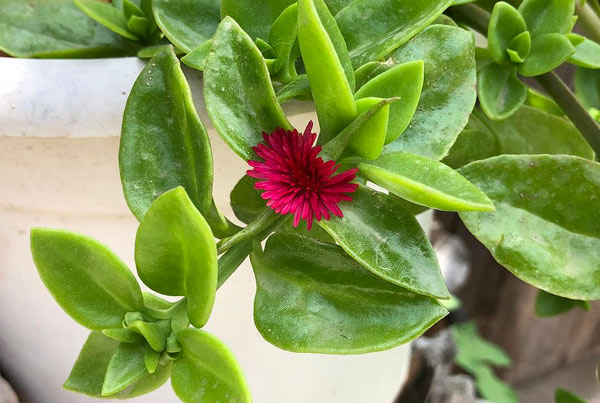
Aptenia Cordifolia History
The genus aptenia belongs to the Mesembryanthemaceae or vygie family. The family name is derived from the Greek word, mesembria, meaning midday, and anthemom, meaning flower, referring to the flowers that open in the afternoon (noon).
The genus name, Aptenia N.E.Brown, is derived from the Greek word, apten, meaning wingless, and refers to the wingless seed. The species name, cordifolia is derived from the in Latin words, cordi, meaning heart, and folium, meaning leaf.
This genus is endemic to South Africa and consists of four species, Aptenia geniculiflora, A. haeckeliana and A. lancifolia. They all occur in the summer rainfall regions of South Africa. Aptenia geniculiflorais is an erect deciduous perennial with 4-angled branches. Baby Sun Rose bears white to pale yellow flowers and occurs on dry flats in scrambling bush found in Namibia to Eastern Cape.
Baby Sun Rose Distribution
Es indigenous to southern and eastern South Africa, although it is naturalized in many parts of the world. There Baby sun rose grows in shady and humid places, generally under trees. Curiously, while there is a small plant, in cultivation, by giving it a large amount of water and sun, Baby sun rose becomes a huge and very invasive plant in a short time, capable of covering entire areas.
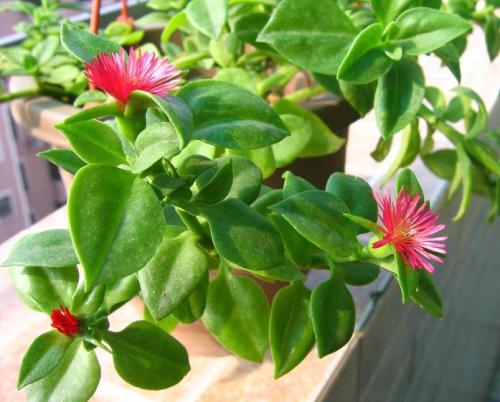
Native Habits of Baby Sun Rose
Baby Sun Rose (Aptenia Cordifolia) is a plant Succulent of family Aizoaceae, the same as living stones and cat's claw. It has a growth mainly creeping, although if it is in the shade it tries to grow upwards, so Baby Sun Rose can climb a little (at most up to about 2m high, generally not more than 1m) and cover low plants. If you give it enough water, Baby Sun Rose is a plant of very fast growth. The stems are green, thin and quite weak, although with time they thicken, lose their greenness and become relatively stiff. The leaves are oval or slightly heart-shaped, attached to the stem by a short petiole. Its common names, dew and frost, are given because in the leaves it has structures called papillae, which are accumulations of water under the epidermis that appear to be dewdrops.The Baby Sun Rose flowers are small, bright pink, with numerous very fine petals and orange stamens. Blooms mainly during spring, which is when the flowers are most abundant, but it produces some loose flowers throughout the year in climates without frost. After flowering, it produces small greenish fruits that go unnoticed and once ripe, they will dry and release small black seeds that do not usually germinate. It can also be said that Baby Sun Rose is a plant edible, but it is only consumed in some parts of Brazil.
Baby Sun Rose likes sunshine, suitable for a dry and ventilated environment. Avoid high temperature wet, like good drainage of sandy soil. Baby Sun Rose is not cold resistant, and the suitable temperature for growth is 15 ~ 25 degrees Celsius. Baby Sun Rose does not have high requirements for fat and water. Generally, the growth period of Baby sun rose is from March to September, during which the water demand is large.
After September, the Baby sun rose will enter the slow growth period. At this time, it is necessary to gradually reduce the amount of watering to prepare for moving indoors for winter.
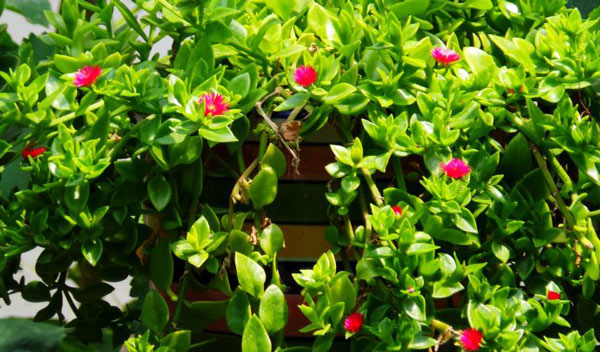
How to Grow and Care for Baby Sun Rose
- 1. Baby sun rose maintenance is simple, a year in addition to the mid-summer noon light should be appropriate shade, other times should be given sufficient light, especially in winter.
- 2. Water demand for Baby sun rose growth period in September is large, so water and spray frequently, in order to increase humidity; Gradually reduce the amount of watering after autumn to improve the Baby sun rose's resistance to cold. Baby Sun Rose can tolerate high rainfall and extreme drought, so they can perform well even with irregular watering. Even so, for best performance, water your Baby sun rose as regularly as you would cacti or succulents.
- 3. Baby sun rose like half shade environment, such as the place of light is too strong or insufficient, leaves will easily become light green or yellow-green, lack of vitality, lose their due ornamental value, or even die of death; Such as direct sunlight, dry air, the most likely to cause scorch, so should be placed in a cool and ventilated place, and pay attention to maintain environmental humidity.
- 4. Baby sun rose is not easy to occur pests and diseases, but such as basin soil water and poor ventilation, in addition to lead to rotting roots, may also occur root rot, should pay attention to spray control.
- 5. Place Baby sun rose in the ventilated position with sufficient scattering light. Because winter is not the growing season of Baby Sun Rose, in order to prevent and control rotting roots, water only when dry, water will be watered thoroughly, depending on the situation!
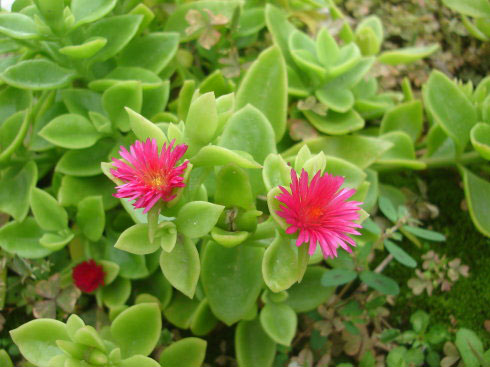
Baby Sun Rose Common Pests/Diseases
In general a Baby Sun Rose healthy will not have pests or if it does, the attack will not be important, but if it does attack something it will be the following:- Cochineal: Like almost all succulents, Baby Sun Rose is susceptible to mealybug attack, but generally it will only attack diseased plants or plants that are severely lacking in nutrients or water. It is very rare to find it in healthy aptenias. To eliminate them, you can use potassium soap or a specific insecticide.
- Snails and slugs: Due to the creeping growth and the water that accumulates on the leaves, it is a perfect hiding place for these animals. They like to eat their leaves, which also helps them to hydrate, but they do not cause notable damage, mainly because of their growth speed. They will only give problems to Baby Sun Rose plants that are too shaded and perhaps those that are in pots. To eliminate them there are poisoned baits, although you can also put a glass of beer in which they will fall and drown. It does not have diseases as such, but it does have deficiencies due to poor cultivation.
- Chlorosis: Chlorosis is called the lack of chlorophyll, which can be caused by different crop failures: lack of some nutrient, generally nitrogen (they are solved by fertilizing or transplanting); lack of water being in the sun (can be solved by watering more); Substrate pH too high or low (solved by fertilizing or changing the pH) ... It is usually accompanied by a reduction in growth. Normally the chlorosis of this potted Baby sun rose plant indicates a lack of water or the need to change the substrate or transplant, but by paying we can postpone that change a bit.
- Decay: Caused by various fungi, it is generally due to excess water or lack of aeration, so it is not necessary to use fungicide but to change the growing conditions. If the entire base has rotted, the branches will have to be cut, removed the rottenness and replanted. Normally in this plant this will only happen in winter, but if we have it flooded it can happen at any time of the year.
How to Propagate Baby Sun Rose
Baby Sun Rose is propagated by cuttings in spring and autumn, which is easy to survive. The propagation of Baby Sun Rose is very simple. Generally, cuttings are adopted: cut off a mature branch, hang it for a moment, and then insert it into the prepared pot soil, put it in a cool and ventilated place, keep the soil slightly moist. After a few days, you can see the branches stand up, which means that new branches have begun to take root.
Read More: How to Propagate Baby Sun Rose from Cuttings
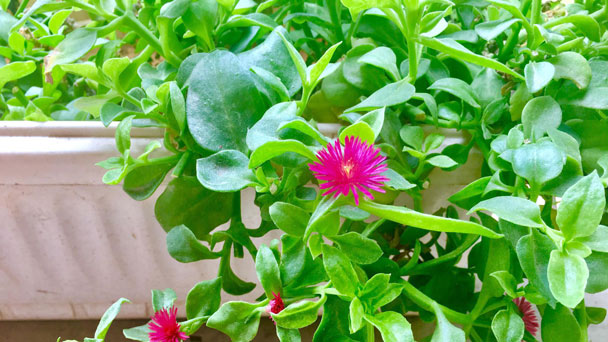
Baby Sun Rose Uses
Baby Sun Rose is used medicinally as an anti-inflammatory, as a dressing (poultice) and deodorant. The Baby Sun Rose plant is also used as a love and good luck charm. Zulu medicinal uses include making a mild enema for babies; the black powder is used for vaccination and against witchcraft (sorcery). Burnt stems and leaves are applied to aching joints.
Baby Sun Rose is used as an ornamental plant and on dry slopes or steep embankments to hold the soil. It requires little care and thrives in the hottest, sunniest, full sun areas in your garden.
If you need a succulent groundcover for an open, exposed area, aptenia cordifolia makes an excellent choice. As an added benefit, it provides very good erosion control. The rambling growth habits make Baby Sun Rose a lovely choice for your rock garden or tumbling over a rock wall. This salt-tolerant heartleaf Baby Sun Rose does well on roadside embankments, terraced slopes, and in seaside gardens.
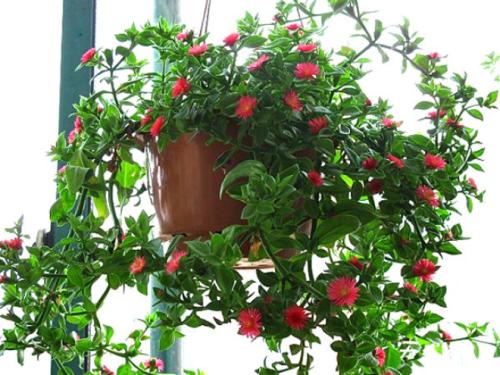
Aptenia Cordifolia Varieties
Aptenia Cordifolia- is a perennial succulent having as common names: Baby Sun Rose, Heart-leaf ice plant or Dew plant.
Aptenia geniculiflora-Aptenia geniculiflora or White-flowered Aptenia is a flowering succulent plant belonging to the Aizoaceae family. This persistent sub-shrub has tetragonal branches with subcylindrical, pale-green leaves.
Aptenia lancifolia- named also Lance-leaved Ice Plant or Purple Aptenia, is a perennial succulent sub-shrub that occurs in the Northern Cape.
Aptenia haeckeliana- called commonly Yellow Sun rose, is a succulent flowering plant native to South AfricAptenia This Aptenia species has 4-angled stems and flat, lanceolate, olive-green to yellowish leaves.
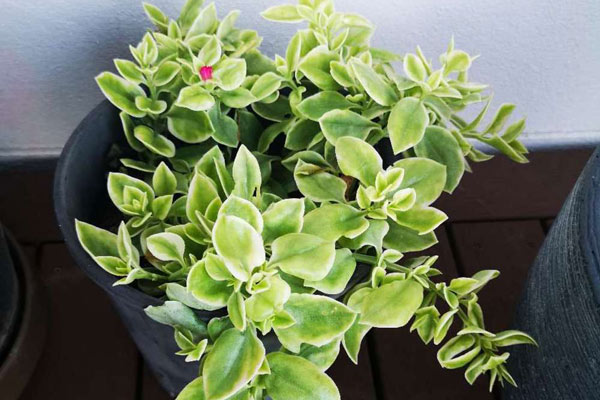
Baby Sun Rose Design Tips
Baby Sun Rose can be very invasive, and when climbing it can cover other plants and kill them. Also, many branches try to climb and fall flat, which is not very aesthetic. This can be solved in several ways:
- Pruning all the branches that go up to other plants.
- Having it as a ground cover in an area where there are only large trees or bushes without low branches that it can climb.
- Keeping it in a pot, where its growth is very reduced.
- Watering it little and not fertilizing it, although this has the negative effect that its appearance will not be the best.
If we have it in a pot, something interesting that can be done is to put a plant with vertical growth that stays green in winter, and an Baby Sun Rose. We place this pot on a pedestal and let the Aptenia grow as a hanging plant. A very beautiful effect is achieved, especially when it is filled with pink flowers. In tropical climates it will always be beautiful, but in frosty climates all the hanging branches will dry up during the winter.
In any case, it is advisable to have it in full sun and without small plants or rocks in between, so that it grows as flat as possible. In this way we avoid the branches that cross and bend and we achieve a much more orderly and beautiful appearance.
Latest Updated
- Benefits of Bugleweed - 7 Science-backed Health Benefits
- Bugleweed Dangers & Side Effects - Is It Poisonous?
- How to Plant Evergreen Trees - What You Should Know
- When to Plant Evergreens - Grow Guide for Evergreen Trees
- 12 Wonderful Evergreen Shrubs for Your Garden
- 12 Popular Evergreen Plants with Pictures for Beginners
- When And How To Prune A Lilac Bush Like a Pro
- How to Grow & Care for Lilac Vine (Hardenbergia Violacea)
- Japanese Lilac Tree (Syringa Reticulata) Care & Propagation Guide
- Shumard Oak Pros and Cons - What to Know
Popular Articles
- Winter maintenance of Antirrhinum Majus
- How to Grow Terminalia Mantaly Tree
- How to Grow and Care for Crossostephium Chinense
- How to grow Antirrhinum Majus in spring
- Peristeria Elata (Dove Orchid) Profile: Info & Care Guide
- Underwatered Snake Plant (Sansevieria Trifasciata) - Signs And How To Fix
- How to Care for Brazilian Jasmine Plant (Mandevilla Sanderi)
- How to Grow & Care for Graptopetalum Purple Delight in Summer
- Rosa Chinensis (China Rose): Plant Growing & Care Tips
- How to Care for Baby Sun Rose (Aptenia Cordifolia)